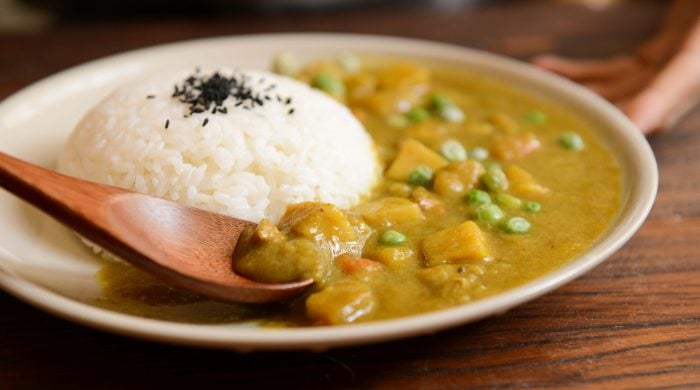*Editor’s Note: Elephant is not your doctor or hospital. Our lawyers would say “this web site is not designed to, and should not be construed to provide medical advice, professional diagnosis, opinion, or treatment to you or any other individual, and is not intended as a substitute for medical or professional care and treatment. Always consult a health professional before trying out new home therapies or changing your diet.” But we can’t afford lawyers, and you knew all that. ~ Ed.
Ayurveda is a system of traditional medicine from India that focuses on creating a balance for the physical body, senses, psyche, and spirit.
A key pillar in Ayurveda for our overall health and well-being is food and nutrition. What to eat is a choice we make multiple times a day and what we put into our bodies influences our mental clarity, emotional stability, hormonal balance, and longevity.
When we choose to eat whole foods according to our Dosha, the Ayurvedic mind-body types, the seasons, and with reverence, we cultivate a connection to our optimal health and highest good.
We are seeing more Ayurvedic superfoods in coffee shops and grocery stores from golden milk to ginger turmeric tonics.
What are some of these beloved medicinal products that have been used for thousands of years to offer the body, mind, and spirit a healthy balance in order to live your highest potential?
“When diet is wrong, medicine is of no use; When diet is correct, medicine is of no need.” ~ Ayurvedic Proverb
Here are four Ayurvedic superfoods you should try:
1. Ginger
We consider this amazing root to be sattvic in nature, meaning harmonious and balancing for all three Dosha types. It is used to increase the pungent and warming qualities. It supports the Agni, digestive fire, helping to aid digestion and decrease bloating.
According to Ayurveda, ginger also helps to relieve respiratory tract issues such as colds and coughs by warming the tissues and moving the stagnant phlegm from the congestion.
Use this medicinal root as a tea or in every meal, grated into oatmeal, soups, kitchari, and curries. Be careful not to overheat the pitta with excessive use.
2. Ghee
Yes, ghee is holy! This pure fat is clarified butter, meaning it has separated out the milk solids, leaving this perfect oil.
Ghee goes through a purification process where what was once a heavy and cold dairy product becomes light and warming in nature. It supports a healthy Agni, digestive fire, and lubricates the tissues. It can also be used topically to nourish the skin, applying it to the face, feet, and hands. Ghee also has a specialty function as it directly nourishes the reproductive tissues as well as the Ojas, which is at the core of our strength and vitality.
So don’t be afraid of this fatty superfood and also no need to overindulge. It helps to lubricate dry Vata qualities, cool the heating Pitta qualities, and balance the Kapha Dosha. You can cook with it, add it to your warm beverage, use it as a spread, or top off your favorite dish.
3. Lentils
Lentils are a staple in Indian diets and throughout the world. It has many varieties, however, we are more familiar with just a few.
This tiny legume is an absolute superfood, packed with folate, fiber, potassium, and antioxidants. Some health benefits include lowering cholesterol, healthy digestion, an excellent source of protein, increased energy, and weight loss. Vegetarian diets are supported by incorporating lentils regularly.
Lentils are used to make traditional Dahl or Kitchari, adding Indian spices and ghee to make a delicious and medicinal meal. The two common lentils are yellow lentils (mung dahl) and red lentils. The yellow ones are considered more tridoshic (balancing for all the Doshas) while the red lentils are more heating as shown by their color.
The best practice is to soak and rinse the lentils, which helps in better digestion and shorter cooking time.
4. Chai
Chai is an absolute favorite in Ayurveda. This spiced beverage is delicious and full of health benefits. The traditional spices of cinnamon, cardamom, ginger, cloves, and black pepper all help to bring warmth to the body and digestion, aiding in a strong Agni and helping to invigorate and move stagnant energy—especially during the colder months.
Adding tulsi and licorice can support the respiratory system, while fennel aids digestion and turmeric offers anti-inflammatory properties.
You can choose your favorite milk to blend with this herbal tonic, making it a frothy cup of yumminess.
Herbal or caffeinated chai is available. However, the caffeine will present some additional things to look at. Nowadays, chai is made with yerba mate, green tea, and, more traditionally, black tea. These are all not as intense as the caffeine load that is found in coffee along with its acidic, astringent, and heating qualities. However, it is still important to look at your overall caffeine intake and how it affects you.
Enjoy this warming and nourishing spicy beverage and allow the aromas to awaken your senses and enliven those cold, winter days.
Ayurveda is so intelligently connected to the natural ways of healing and returning to balance.
Explore these Ayurvedic superfoods, and I hope you fall in love with their delicious and medicinal offerings.









Read 10 comments and reply